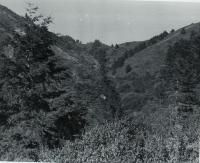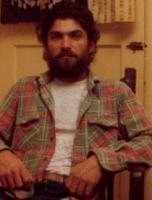I got to know the Coastside Comet Editor George E. Dunn’s son, also called George Dunn–and he was retired when I met him and he had been a newspaper man, too–and he insisted I have this photograph of Ox Mountain, because, he said, this is what that beautiful place looked like before it became a county wide refuse dump off Highway 92, a couple of miles east of the town of Half Moon Bay.
1918 Flu On the Coastside: Part III
The influenza pandemic struck the Coastside in September 1918. The killer flu had moved from the east to the west coast but strangekly the epidemic was not the lead story in the newspapers. Was it because World War I was still raging with young American soldiers dying in the trenches in Europe?
In the U.S. army bases– crowded with recruits waiting for orders to go off to war–were hard hit by the virus. In the big East Coast cities, the manufacture of coffins lagged far behind the number of bodies needing burial, according to Alfred Crosby’s book, mentioned in earlier posts.
Like wildfire, the virus cut a wide swath of devastation behind as it headed to the West Coast. At its peak some 30 cases were reported daily in San Mateo—fortunately, the deaths from this horrific flu never matched the numbers back East.
No matter, everyone was frightened of every sneeze, of every sniffle, of every cough. In San Francisco legislation required “every person appearing on the public streets to war a mask”. While protective masks were serious business, some in the fashion world made light of it, adding masks as an accessory to the latest fall wear for women.

The Coastside Comet’s Editor George E. Dunn. The Comet was located in Moss Beach and the building still stands on Hwy 1.
The Coastside Comet building later served as a U.S. post office, real estate and electric company office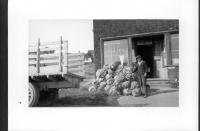 –and as the headquarters for local photographer R. Guy Smith–who had been the postmaster and real estate agent! What’s in all those bags?
–and as the headquarters for local photographer R. Guy Smith–who had been the postmaster and real estate agent! What’s in all those bags?
Following San Francisco’s lead, a similar “mask” resolution was passed by a special session of the San Mateo County Board of Supervisors. The penalty for being caught without a “muzzle” was a $100 fine and or ten days in jail.
Most everyone obeyed the law and wore pads of gauze tied in place with strings around the head. Mailmen and barbers and store clerks wore the mask. They were hot, scratchy and impractical.
One of Pescadero’s most controversial citizens, Loren Coburn, a grumpy landowner who was always at odds with the villagers, wore the mask but still fell ill and died at age 92. The flu also struck down Howard Frey, who at 24 apparently fit the more common profile of those who died.
More importantly, some believed the masks violated their personal liberties–and they made their voices heard.
That year Thanksgiving was a real thanksgiving as the epidemic began to pull back, with the bureaucrats who promoted mask wearing taking credit. But there were skeptics and Coastside Comet Editor George E. Dunn was one who questioned the efficadcy of the gauge masks. Dunn knew Coastsiders who had worn the mask and still succumbed to the flu.
The Coastside’s George E. Dunn knew San Francisco Board of Health Chief Dr. William Hassler– (who wore the “snort” version of the gauze mask, which observers said gave him a “pig-like” appearance–and the editor asked, “Answer this. Why is it that some folks who wore a muzzle on their mouths caught influenza and some folks who didn’t wear a muzzle didn’t catch influenza? Speak up!”
If there was an answer, it went unreported. (Dunn was later vindicated, as medical evidence indicated the mask offeredno significant protection).
By December the worst was over–and six days later this ad appeared in George Dunn’s Coastside Comet: “Two secondhand flu masks for sale, both in good order….”
Memory Lane
Who is the handsome couple?
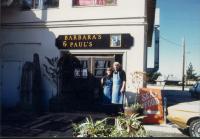 (Click on image to enlarge. Photo by Jerry Koontz for a slide show I put together).
(Click on image to enlarge. Photo by Jerry Koontz for a slide show I put together).
Do you remember “Barbara’s and Paul’s”–the popular seafood restaurant located in the old Ocean Shore Railroad station in El Granada? After Paul’s untimely death, Barbara opened the “Fishtrap” in Princeton–where Hazel had her place for so long and before that it was a Prohibiton roadhouse.
Interlude With A Beautiful Plant
Overheard
Overheard outside the El Granada post office
Locals talking, worriedly, about friends being rear-ended on Highway 1. “It’s happening all the time,” one woman said.
My boyfriend’s car was rear-ended two weeks ago at 8:15 a.m. near Miramar. Popped and broke the trunk lock and scared him– no wonder, his small car was struck by a monster SUV.
He called me and I ran down to make sure everything was okay. On the ground I found this small jagged piece of gray plastic. I picked it up only because I thought it was part of our car’s bumper or something–. I was holding the useless piece of plastic when the young man who hit my friend’s car (the kid must have been in “shock”) took the plastic from me, thanking me over and over as if it was worth a million dollars–by the way the house across the street sold in one week for $1.2 (see earlier post).
I have often dreamed of closing Highwy 1 between Princeton and Miramar, leaving the foot and bike paths–but we need access–something to work on. It seems like a good idea to close the automobile road between those two points.
Fog Fetish?
1918 Flu On the Coastside: Part II
At the end of World War I– between the fall of 1918 and the early 1920s– an influenza pandemic was stealing millions and millions of lives all over the world. It was a contagious, ruthless flu that preferred to take the breath away from adults in the prime of life–but in the end everybody was at risk.
The Coastside was isolated and that’s why folks from the surrounding areas thought they could escaqpe falling ill here. Entire families rented cute Ocean Shore Railroad era cottages that San Franciscans had built as second homes or to commute to the City from.
The pandemic hit the Coastside in mid-September 1918. The killer virus struck locals who, through their work and social status, had contact with many more people. Harry Nelson, the postman fell ill so did Father J. Sorasio.
Here were the reported symptoms,typical of the average flu: First fever, headaches and backaches. Bed rest and plenty of liquids was recommended but this time the prescription failed.
If you read Alfred Crosby’s book, “The Forgotten Pandemic: The Influenza of 1918”, he writes that death came quickly for many victims, with autopsies showing blue, swollen lungs filled with a thin, bloody fluid.
People were terrified. They suspected coughs and sneezes were passing the virus. San Francisco enacted legislation requiring everybody to wear a mask when in public.
I’m sure there was great sadness down at Pigeon Point, south of Pescadero, when the two young sisters Emma and Clara Steele fell ill and never recovered to live out the rest of their lives. As the flu spread its blanket of doom and gloom, Half Moon Bay closed schools and set up “hospitals” inside private homes. But nurses and doctors were scarce as they had too many patients to care for and caught the flu themselves.
Clara (second from left} 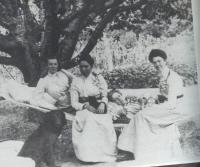 and Emma Steele, reclining, young Coastsiders who fell victim to the flu in 1918. Photo courtesy Mrs. Stanley Steele
and Emma Steele, reclining, young Coastsiders who fell victim to the flu in 1918. Photo courtesy Mrs. Stanley Steele
Driving Over Devil’s Slide–Enjoy The Views
Musical Interlude
I love all kinds of music, opera, classical, pop, folk, jazz, electronic, etc. but if you love rock and want to go back to your 60s roots, I highly recommend the Swedish group’s latest release, “dungen ta det lugnt”. I dont’ care that it’s sung in Swedish, I get it, and the Jimi Hendrixish electric and accoustic guitars make me want to be a rock ‘n roll star all over again.
This is music that changes from an almost symphonic construction to raging, terrific rock. Sometimes they have a wonderful Beatle-ish sound, very sweet, and then they can get very tough. Very classy.
Swedish rockers Dugen’s “ta det lugnt”
The end of the 4th track is just amazing. The whole work, which I see as a kind of “rock” opera because of the theme repetition brings back shades of many of the greats from the 60s, but, oh, so much better.
1918 Flu On the Coastside: Part I
There’s lots of talk these days about two “hot” and scary topics: an earthquake that turns San Francisco into the “temporary city” and a super-flu that makes the 1918 pandemic look like the common cold. And there are many books to choose from about these horrific possibilities, among the latest “A Crack in the Edge of the Earth:America and the Great California Earthquake of 1906” by Simon Winchester (about the freakishness of geology that I’m currently devouring) and “The Great Influenza: The Epic Story of the Deadliest Plague in History” by John M. Barry which I will read next.
In these strange times echoing with uncertainty on all sides, these non-fiction books seem like good old Stephen Kingish horror stories.
Many years ago I had already read “America’s Forgotten Pandemic: The Influenza of 1918” by Alfred Crosby which I highly recommend. In addition I read author Katherine Anne Porter’s personal account of how she survived the 1918 pandemic in her short story, “Pale Horse, Pale Rider”. Ms. Porter was in such fear that she wouldn’t allow herself to drift off into sleep–she had convinced herself she wouldn’t wake up if she closed her eyes.
Figures on deaths worldwide from this fast-moving flu have increased from what I initially read was about 22 million to 50 to 100 million. And now there are reports that the flu was a bird flu.
The San Mateo County Coastside, reeling from the failure of the Ocean Shore Railroad to open up this isolated, gorgeous stretch of artichokes and lonely beaches, became a health- haven for San Franciscans fleeing the deadly influenza in 1918. But the Coastside didn’t escape the flu–the community, widely spread between farms, bungalos serving as vacation homes for railroad commuters, and a couple of tiny agricultural towns, didn’t escape the deaths and because of the close-knitness of the people, these losses were keenly felt.
In 1918 ( just as in 1906 when some earthquake- fearing city folks, fled to the Coastside where they hoped the ground wouldn’t shake beneath their feet) entire families sought safety on the Coastside. Hard-to-rent Ocean Shore RR-era cottages became homes again in a previously lackluster real estate market.
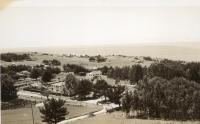 The Coastside was sparsely populated, thought to be a perfect place to flee from the killer 1918 flu.
The Coastside was sparsely populated, thought to be a perfect place to flee from the killer 1918 flu.
Just as people rushed into the Coastside, some rushed out. Miss Irmagarde Hazard, a teacher at the Montara School, packed her bags and left for San Luis Obispo, hoping she would outrun the worldwide epidemic.
The killer flu struck the Coastside in mid-September. Two important members of the community fell ill, the rural postal delivery man and a Catholic priest.

